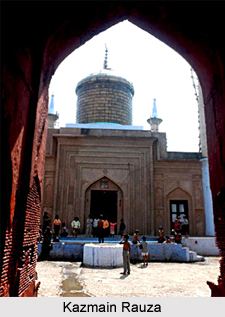 Kazmain Rauza, located in the city of Lucknow, is said to be a replica of the sacred mausoleum of the seventh and eighth Imams of Khurasan, namely Hazrat Moosa Kazim and Imam Hazrat Ali Raza. This particular monument belongs to the second phase of Nawabi architectural constructions in Lucknow(1800-1856). This period comprises those monuments which belong to the first half of the nineteenth century, before Awadh was annexed by the British. These monuments are characterised by a hybrid style, incorporating Indo-Muslim and European elements.
Kazmain Rauza, located in the city of Lucknow, is said to be a replica of the sacred mausoleum of the seventh and eighth Imams of Khurasan, namely Hazrat Moosa Kazim and Imam Hazrat Ali Raza. This particular monument belongs to the second phase of Nawabi architectural constructions in Lucknow(1800-1856). This period comprises those monuments which belong to the first half of the nineteenth century, before Awadh was annexed by the British. These monuments are characterised by a hybrid style, incorporating Indo-Muslim and European elements.
Architecture of the Kazmain Rauza
The central part of the complex consists of a square building with a square courtyard enclosed within an outer and an inner boundary wall. The large central chamber has the Rauza whereas the tombs of Nawab Sharf ud daula and his wife Sharf un nisa lie near the threshold. In accordance with Shiite traditions, the tombs are on level with the marble floor, on which is inscribed the burial date, A.D. 1852. The one-and-a-half century old edifice is capped with two large and impressive domes, which are covered with copper sheets and painted in gold. On the four corners are Isfahani minarets, creating an impressive facade. Floral motifs have been made on the indigo-coloured Lakhauri brick lime. The ornamentation, seen mainly on the lower part of the minarets, on the walls of the `Ghulam Gardish` and on the arches and lintels of doors, is however, fading.
There are six entrances to the courtyard, one of which is the Sadar Phatak. A Hauz has been provided at the rear of the building. All around, there are rows of Sahanchis. According to a Persian verse inscribed in the Nastaliq script, on a black stone tablet fixed over the western entrance, the edifice was constructed during the reign of Sultan-i-Alam Badshah (i.e. King Wajid Ali Shah) at the instance of the benefactors of the people, Sharaf ud Daula and his wife Sharaf un Nisa Khanam, copying the architectural style of Shiraz (Iran). The chronogram comprising the word `Mazar-i-Kazmain` yields the date of completion as A.H.1269 (A.D.I852-53). The epigraph also records that the honour of religion in Lucknow became the envy of the garden of paradise.
The large courtyard to the east of Kazmain is known as the `Katlgah` or the place of murder, and decorative Tazias are brought here. The Mom ki Zari of the Chhota Imambara is traditionally buried in this very Karbala. Not far from it is the Kufa (Iraq) Wali Masjid, wherein lies the Rauza of Haji Hazrat Muslim. There is an interesting anecdote regarding the Chup Tazia of Lucknow which was brought from Nazim Saheb ka
Imambara to this very Karbala after the eighteenth day of Chehalum. During the nineteenth century, this famous Tazia of Nawab Aqqan Mian`s Khandan was raised on the day of Chehalum. During one such occasion, Nawab Saheb was arrested and by the time he was released Chehalum was over. Consequently, the Tazia could not be moved
from his residence and so he shifted it secretly (Chup Chap) on the day of the demise of
the eleventh Imam, Hassan Askari. The Tazia procession, proceeding from Patanala, was
accompanied only by a narrator reciting holy verses. This, in a nutshell, is the history of
Lucknow`s `Chup Tazia`.
The Kazmain Rauza thus mentioned is one of the many monuments adorning the beautiful landscape of the city of Lucknow.




